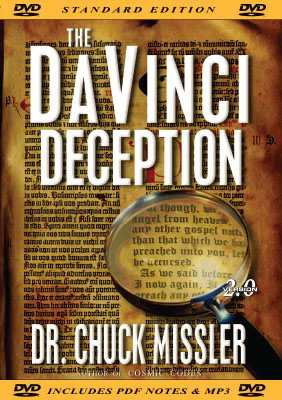As we said before, so say I now again, If any man preach any other gospel unto you than that ye have received, let him be accursed.
Galatians 1:9
As we've said in our previous two issues, the popular but shamefully blasphemous novel by Dan Brown, The Da Vinci Code, has raised many troubling questions, particularly among the less informed, and with a major motion picture in the works, this subject will be a popular topic of conversation for months to come.
In his novel, Dan Brown attempts to support his outrageous notions by using allusions from the Gnostic Gospels and twisted distortions of the early church councils, all of which raise serious questions: What makes us so confident that our Bible is what it purports to be? How do we know? What about these "missing" books of the Bible?
Brown's distortion of history is rampant throughout his novel. He assumes that Constantine made Christianity the state religion of the Roman Empire-rather, he simply granted freedom of worship in his Edict of Milan in A.D. 313. It was a subsequent successor, Theodosius (379-395), who made Christianity the state religion in 381. Brown's Constantine "upgraded a mortal Christ to deity," and "secured male dominance and suppression of women"... "converting the world from matriarchal paganism to patriarchal Christianity." He insists that Constantine canonized selected favorable Gospels from "more than 80 available." His deliberate distortions are, of course, contradicted by clear historical records.
Council of Nicaea
The Council of Nicaea was convened in A.D. 325 with 318 bishops to settle disputes about Christology, not to dispute or modify the "canon." ("Canon," meaning standard, refers to those Scriptures that were accepted by the early churches as God-breathed, or inspired.) The principal precipitating issue was between Arius and Athanasius. Arius argued that Jesus was simply a created being. He was a great communicator and was causing deep disputes throughout the Empire. Athanasius argued for the full deity of Christ and was clearly vindicated by the proceedings of the Council (as exemplified by the famous Nicene Creed).
Brown's Version
"It was at the Council of Nicaea in 325 that Church leaders decided by vote to make Jesus divine...Until that moment in history, Jesus was viewed by His followers as a mortal prophet."
And, according to Brown, it was a "close vote"! According to him, the presently accepted Gospels were selected from "more than 80" available. All of this is deliberate misrepresentation to support his attack on Jesus Christ and His church.
Twenty rulings were issued at the Council of Nicaea and the contents of all of them are still in existence: not one of them involved issues regarding the canon.
As for the vote that was finally taken, only 5 out of 318 dissented; only two of those refused to sign the resulting resolutions, which reaffirmed the deity of Christ, not issues regarding the canonical Gospels.
If Christ was not fully God, then God was not the Redeemer of mankind.
For by him were all things created, that are in heaven, and that are in earth, visible and invisible, whether they be thrones, or dominions, or principalities, or powers: all things were created by him, and for him:
Colossians 1:16 (Also, see Jn 1:1; Rom 9:5; Heb 1:1-8; etc.)
During the 1st century-two centuries before the Council of Nicaea - even before the end of His earthly ministry, Christ's divinity was already being acknowledged, as evidenced by Thomas: "My Lord and my God!"1
During the 2nd century - still a hundred years before the Council of Nicaea - we have ample quotes from the early church fathers:
- Ignatius, Bishop of Antioch (A.D. 110): "There is One God who manifests himself through Jesus Christ his son"; "Son of Mary and Son of God, Jesus Christ our Lord, God Incarnate, Christ God," etc.
- Polycarp of Bishop of Smyrna (A.D. 112-118), in his letter to the church at Philippi, assumes the divinity of Jesus, His glorification, etc.
- Justin Martyr (~A.D. 150): "being the first-begotten Word of God, is even God"2; "...both God and Lord of hosts."3
- Irenaeus (~A.D. 185): "our Lord, and God, and Saviour, and King."4
- Clement of Alexandria (~A.D. 200): "truly most manifest Deity, He that is made equal to the Lord of the universe; because he was His Son."5
Another of the often-overlooked rebuttals to those who deny Christ's claim to deity were the persecutions in Rome, and the voluntary martyrdom of the early Christians for their refusal to worship the emperor. Their martyrdom was a result of their exclusive commitment to Christ as God.
How We Got the New Testament
The New Testament was canonized in the 1st century while the apostles were alive and all facts could be checked out (Lk 1:2; Acts 1:21,22; 1 Jn 2:3). It was endorsed by Christ in advance (Jn 14:25-26) and was considered a "more sure word of prophecy" (2 Pet 1:16-19).
The Process
Letters were received and then circulated by the early church, and a growing group of them became recognized as authoritative (Apostolic) and in harmony with accepted doctrine. All 27 books were accepted by the end of the 1st century and every New Testament book was cited as authoritative by a church father within one generation.
The Gnostic Gospels
The term "gnostic" refers to gnosis , or knowledge. However, here it refers to the concept of hidden, secret, or special knowledge. The Gnostics were a growing problem in the early church and many of the New Testament epistles, as well as the numerous quotes from the early church fathers, were in rebuttal to the several heresies promoted by the Gnostics.
(In fact, Paul's second letter to the Thessalonians was a response to a forgery being circulated as if from him.6)
For the time will come when they will not endure sound doctrine; but after their own lusts shall they heap to themselves teachers, having itching ears; And they shall turn away their ears from the truth, and shall be turned unto fables.
2 Timothy 4:3
A large number of spurious documents emerged during the centuries following the ministries of the Apostles and were universally rejected by the early church. Copies of a group of these were found at Nag Hammadi (in Egypt) dating from the 3rd and 4th centuries, and these are uncritically accepted by Brown as accurate. These include The Gospel of Thomas, The Gospel of Philip, The Gospel of Mary, The Gospel of Truth , and about four dozen others
They are not "Gospels" at all, but rather speculative opinions, totally devoid of any verifiable facts. Furthermore, they were written under false pseudonyms in an attempt to gain legitimacy. The early church rejected any documents under pseudonyms as being inconsistent with the concept of God-breathed inspiration.7
Lastly, they were all written centuries after the Gospel period - in contrast to the contemporaneous eyewitness accounts in the New Testament - and make no pretense of being actual records of events - in fact, they are anti-historical rather than simply non -historical!
In particular, Brown leans on The Gospel of Philip and its out-of-context fragmentary reference to a kiss - in which Jesus ostensibly kissed his other students as well - but this still suggests nothing about marriage or any sexual innuendo. Brown leans on a word in the "Aramaic" (although The Gospel of Philip came to us in Coptic!) that he maintains means "spouse." The word actually happens to be a loan word from the Greek: koinonia , which can mean companion, as in fellowship, etc.
The Gospel of Philip makes no reference that supports any of Brown's contentions. But even if it did, it would be irrelevant since it was written more than two centuries after the Gospel period, under a pseudonym posing as someone he wasn't. No serious scholar can take it seriously as having any historical merit.
(Many would seem to accept Napoleon's cynical perspective: "What is history, but a fable agreed upon?")
The popular novel is, indeed, malicious, deliberate fiction - posing subtly as factual - and is clearly, itself, a fulfillment of prophecy:
Even as there shall be false teachers among you, who privily shall bring in damnable heresies, even denying the Lord that bought them, and bring upon themselves swift destruction. And many shall follow their pernicious ways; by reason of whom the way of truth shall be evil spoken of. And through covetousness shall they with feigned words make merchandise of you:
2 Peter 2:1-3
But it can also be a blessing by causing serious Christians to "do their homework" and find out just how the Bible came into being and the process by which the New Testament achieved codification during their early years.8
For there must be also heresies among you, that they which are approved may be made manifest among you.
1 Corinthians 11:19
Codes Brown Didn't Include
We will continue this series with a review of some surprising aspects involving the Tribe of Dan, the associated Merovingian Myths, and some of the contemporary implications of the Magdalene Heresy and their possible role in the unification of the New Europe today. We will also highlight some bizarre speculations regarding a 150 ft. statue of "Mary Magdalene," wearing a toga and holding the "Holy Grail," that graces an international port to this day. Stay tuned.
Notes:
- John 20:28. See also John 1:1; Titus 2:13; Hebrews 1:8-10; 1 Peter 1:1, et al.
- First Apology , ch. 63.
- Dialogue with Trypho , ch 36.
- Against Heresies , bk1, ch 10.
- Exhortation to the Heathen, ch 10, Vol 2. All of these references can be found in Alexander Roberts and James Donaldson, The Ante-Nicene Fathers : Translations of the Writings of the Fathers Down to A.D. 325, 10 Vols.
- 2 Thessalonians 2:2.
- The Epistle to the Hebrews is the notable exception. It appears to be the 3rd of a trilogy on Habakkuk 2:4, along with Romans and Galatians.
- These topics are covered in our Learn the Bible in 24 Hours publication , and also in our briefing package, How We Got Our Bible.





